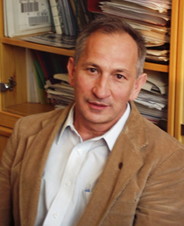Project OPUS
Fundamental Properties of Strongly Correlated Systems:Strong Electronic Correlations, Unconventional Superconductivity, and Topological Properties of Selected Quantum Materials

|
|
Our project concerns the physics of electronic properties of the strongly correlated quantum materials. In those systems interactions between particles are larger than the energies of individual particles. Hence, their dynamics (motion) is mutually correlated. In such systems the interaction cannot be regarded as a perturbation of their individual behavior. Rather, specific mathematical and advanced computer-guided methods must be implemented in order to pursue a quantitative analysis of their measurable physical properties and compared with the available experimental data. This is the reason why the progress in this complex field is systematic, but still under an intensive debate.
In those systems unique and singular phenomena are observed. One of them is the singular behavior (quantum critical phase transition), which in turn leads to the appearance of novel and unexpected collective states. Another example is high temperature superconductivity in the cuprates, where the electronic superfluidity evolves from the (Mott) insulating state. The discovery of this superconductivity is only one of a number of unconventional superconducting (superfluid) states, which have become known in the last three decades. The most recent of them is the discovery of those phenomena in twisted bilayer graphene (TBG), a strictly twodimensional material, which beautifully complements the earlier findings concerning the superconductivity and the correlation effects of in quantum matter. The unique feature of TBG is through its electronic properties it exhibits also certain universal topological features, as exemplified by the appearance of topological quantum numbers such as the Chern number. Moreover, several groups (including ours), have recently suggested that the electronic properties of the TBG might exhibit certain universal topological features, as exemplified by the appearance of topological quantum numbers (Chern number) and robust edge states.
Our contribution to this complex field is as follows. First, we provide a quantitative theory of high temperature superconductivity, based on the idea of electron pairing in real space and provide solution with the help of an original (variational and other) methods, within which we can also incorporate other coexisting collective phases, such as charge density wave states. We generalize our former successful one-band theory to the multi-band situation and apply it subsequently to other systems, i.e., those with very heavy electrons (the heavy-fermion systems), as well as to TBG. The philosophy of our research effort is to be close to the current experiment of research and to carry out a quantitative comparison of theory with observations. It is established clearly, that the strong-correlation picture forms a proper framework of treating the phenomenon of unconventional superconducting for the systems mentioned above, but the quantitative approach is still in the making.
Second part of our research project is to incorporate properly the interelectronic correlations into the singleparticle dynamics to provide their revised (renormalized) picture from the quantum point of view. For this, we have to combine the quantum-wave-mechanical and the particle (field-theoretical) pictures into a coherent scheme, within which we can approach both the dynamical properties (photoemission and tunneling spectra) and the above mentioned collective (thermodynamic) properties at the same time. Implementation of this scheme is quite involved, both analytically and computationally. Therefore, the treatment will be applied first to relatively simple materials, such as CeCoIn5 or single-planar cuprates. Advanced methods of this kind have been proposed earlier (e.g., LDA+U, LDA+DMFT) and they have been quite successful when applied to selected materials. Our proposal tries to avoids certain loopholes of the former approaches, such as the double counting of the interparticle interaction. In brief, we provide within a single framework, both single-particle and collective properties. So far, we have obtained in this part important nontrivial results for correlated nanophysical systems and for the metallization of molecular hydrogen in low-dimensional situations (one- and two-dimensional cases).


